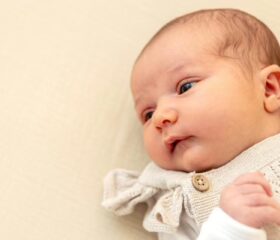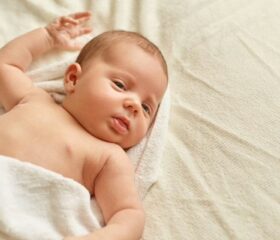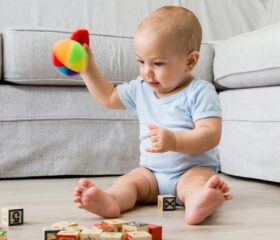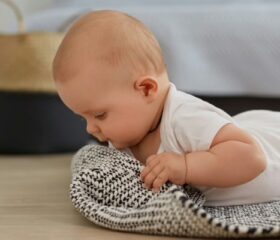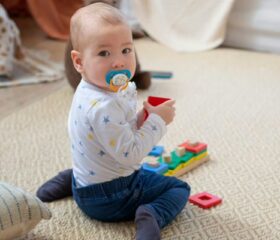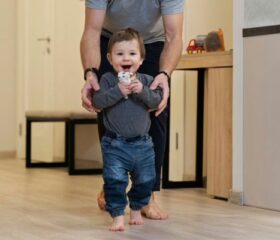Baby Hair: A Comprehensive Guide to Growth, Loss, and Care
It’s normal to wonder what’s going on with your little one’s hair. Newborn hair can vary dramatically—some infants are born with full heads of luscious locks, whereas others are born with perfectly bald pates.
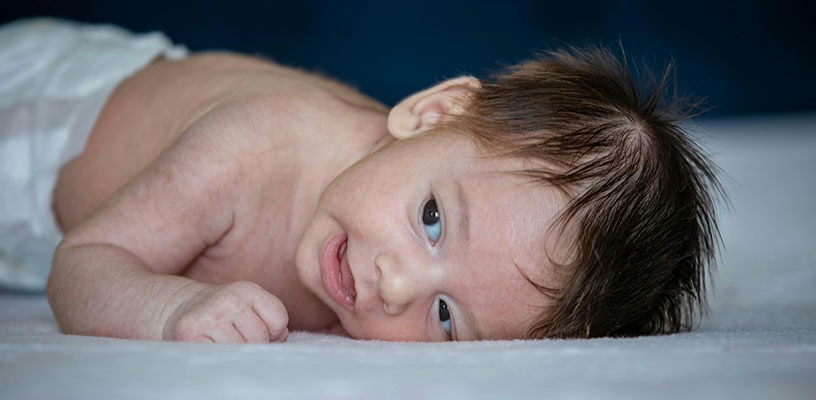
- Why are some babies born with hair and some aren’t?
- Why many babies lose their first heads of hair
- When will your baby's hair grow back?
- When should you see a doctor about your baby’s hair?
- Caring for your baby's hair: tips and tricks
- When to consider getting your baby his first haircut
- Final thoughts
This article will cover everything you need to know about your baby’s hair, from growth and loss to care tips and when to consider getting your newborn his very first haircut.
Why are some babies born with hair and some aren’t?
All babies begin developing hair follicles in the womb at around 9 weeks to 10 weeks of pregnancy. 1 However, some are born with full heads of hair, while others have barely a wisp.
Both states are completely normal, and how fuzzy your baby is at birth probably boils down to genetics and their hormonal balance in the womb. Environmental factors, such as your nutrition during pregnancy and any drugs or medications you were on, may also play a role.
When newborns have hair, it’s usually finer and softer than the locks they’ll have when they’re grown. This hair is temporary and often sheds within the first 6 months, though hair loss usually peaks when babies are around 3 months old. 2
Seeing your newborn’s hair fall out can be alarming, but it’s also perfectly normal and is no cause for concern.
Why many babies lose their first heads of hair
Most infant hair loss occurs within the first 6 months, and, in fact, it actually starts much earlier in the womb. While in utero, your baby is covered with a fine, downy hair called lanugo. Most babies lose this during gestation, usually when you’re around 33 weeks to 36 weeks pregnant, although some still have a little when they’re born. 3
Shedding happens when your baby’s hair follicles, which were previously in a growth state, enter a “resting” state, known as telogen. This cycle between growth and rest states, called the telogen wave, is the same biological process that governs your own hair, and not something that’s specific to newborns. 4
Following birth, babies experience hormonal shifts that make their hair loss more pronounced than the shedding that adults experience. Still, it won’t be long before your baby’s follicles shift back into their growth mode and he starts growing his first “real” head of hair. 5
Do any skin conditions cause infant hair loss?
There are a few common skin conditions that can lead to hair loss in infants, including cradle cap, also called seborrheic dermatitis. This mild condition causes dry, scaly patches to grow on your baby’s scalp. 6
Most of the time, cradle cap clears up in a few weeks or months on its own, but ask your doctor about it during one of your baby’s checkups—they’ll tell you if you need to apply any medication.
If they don’t, you can still soothe your baby’s head with at-home treatments. Gently massage mineral or coconut oil into his scalp, then use a soft brush to remove the flakes before shampooing. The key word here is “gently”: scraping or brushing aggressively can worsen the irritation.
How friction contributes to infant hair loss
Note that sometimes, your baby’s shedding might also be exacerbated by friction. This usually comes from your baby rubbing against a firm surface (e.g., while lying on his back in his crib), which can cause hair loss on the back of his head. 7
This will also be temporary, but if you can, try to avoid it to minimize irritation to your baby’s scalp. We’ll provide a few tips on how to do that below.
When will your baby's hair grow back?
Each baby’s hair growth timeline is unique, but in general, you can expect your baby’s hair follicles to start producing new hair within 12 weeks. It may take 6 to 12 months for his hair growth to become really noticeable. Speak to your doctor if your baby’s hair doesn’t grow back by the time he’s 12 months old. 2
Will your baby’s hair change when it regrows?
Yes, as your baby’s hair grows back, you might notice changes in its color and texture. The soft “vellus” hair that many babies are born with will gradually transition into terminal hair, which is thicker and more like adult hair. 3 This transition happens as the hair follicles mature.
Hair color can also change over time—babies born with dark hair may develop lighter locks, and vice versa. These shifts can be dramatic or subtle. Ultimately, your baby’s hair may continue evolving throughout his childhood. 8
When should you see a doctor about your baby’s hair?
Most baby hair changes are normal, but call your pediatrician if your child’s hair falls out and doesn’t at least begin to grow back within a year, or if you notice any of the following: 2
- Scabs or crusts in his hair
- Signs of ringworm on his scalp (a round patch of hair loss with scales, rough surfaces, and redness or itching)
- Persistent hair loss
- Patchy bald spots
- Black dots on the scalp
- A red and very swollen scalp, especially in an area with significant hair loss
It probably goes without saying, but you should also get in touch with your pediatrician if you notice anything else concerning, such as your baby acting lethargic. Especially coupled with a lack of hair growth, this can indicate nutritional deficiencies or other health issues.
Caring for your baby's hair: tips and tricks
Regardless of how much hair your baby has, proper care will keep his scalp healthy. Follow these tips:
- Gently massage your baby’s head: Rubbing your baby’s scalp with your fingertips or a soft brush can increase follicular blood flow, but don’t over-brush. If you go too hard, you’ll do more harm than good. Also, avoid brushing wet hair (i.e., after bath time), as it’s prone to breaking.
- Don’t over-wash: On that note, avoid over-washing your baby’s hair. Twice or three times a week is enough to maintain his scalp health while preserving his natural oils. 9 Use tear-free, natural shampoos without harsh chemicals.
- Skip tight hairstyles: Tight ponytails or braids can cause breakage. If you want to add accessories to your baby’s hair, opt for soft headbands.
- Minimize friction: Vary up your baby’s poses to reduce the pressure on the back of his head. Practically from the get-go, you can (and should) introduce tummy time, which develops your baby’s motor skills and muscles. This will also give his head a break and make sure he only sheds hair when his body wants to.
- Protect your baby from the sun: It’s very important to make sure your baby doesn’t get too much sun exposure, especially if he doesn’t have hair yet (but even if he does). If he’s going to be in the sun, he should wear a hat if he’s under 6 months old, and use mineral-based sunscreens if he’s older than that.
- Pay attention to your baby’s diet: Breast milk or formula provides all the nutrients your baby needs for the first 6 months of his life. Once you introduce solids, make sure he eats a varied diet. Foods rich in protein, vitamins A, B, C, E, iron, and omega-3 fatty acids all support hair growth. 10
When to consider getting your baby his first haircut
There’s no right or wrong time for your baby’s first haircut. Don’t rush it; cutting his hair early or shaving his head won’t make his hair grow back thicker or faster (a common myth).
Many parents choose to wait until their baby’s hair starts getting in his eyes or tangling. At that point, it may be time for a trim.
Haircuts are tricky with squirmy babies. Consider booking an appointment with a professional stylist who’s experienced with young children.
If you opt to cut your baby’s hair at home, use short-bladed scissors, have another adult help, and ensure your baby is calm and well-fed before you start. Waiting at least a year until your baby has better head control can make things easier.
Final thoughts
Hair loss and regrowth in babies are both entirely normal. If you have any lingering concerns, don’t hesitate to talk to your pediatrician, but otherwise, just be gentle with him and take all the steps you can to promote his hair growth and scalp health.
And take lots of pictures—as you know, his hair may change dramatically as he gets older, and these early stages will pass quicker than you think!
Article Sources
- MedlinePlus. "Fetal development" Retrieved July 21, 2025.
- Seattle Children’s. "Hair Loss" Retrieved July 21, 2025.
- StatPearls. "Embryology, Lanugo" Retrieved July 21, 2025.
- American Osteopathic College of Dermatology. "Telogen Effluvium Hair Loss" Retrieved July 21, 2025.
- Cleveland Clinic. "Why Is My Baby Hairy? Newborn Body Hair Explained" Retrieved July 21, 2025.
- MedlinePlus. "Dandruff, Cradle Cap, and Other Scalp Conditions" Retrieved July 21, 2025.
- American Academy of Pediatrics. "Hair Loss" Retrieved July 21, 2025.
- American Academy of Pediatrics. "Your Baby's Head" Retrieved July 21, 2025.
- American Academy of Pediatrics. "Bathing Your Baby" Retrieved July 21, 2025.
- United States Department of Agriculture. "Infant Nutrition and Feeding" Retrieved July 21, 2025.
